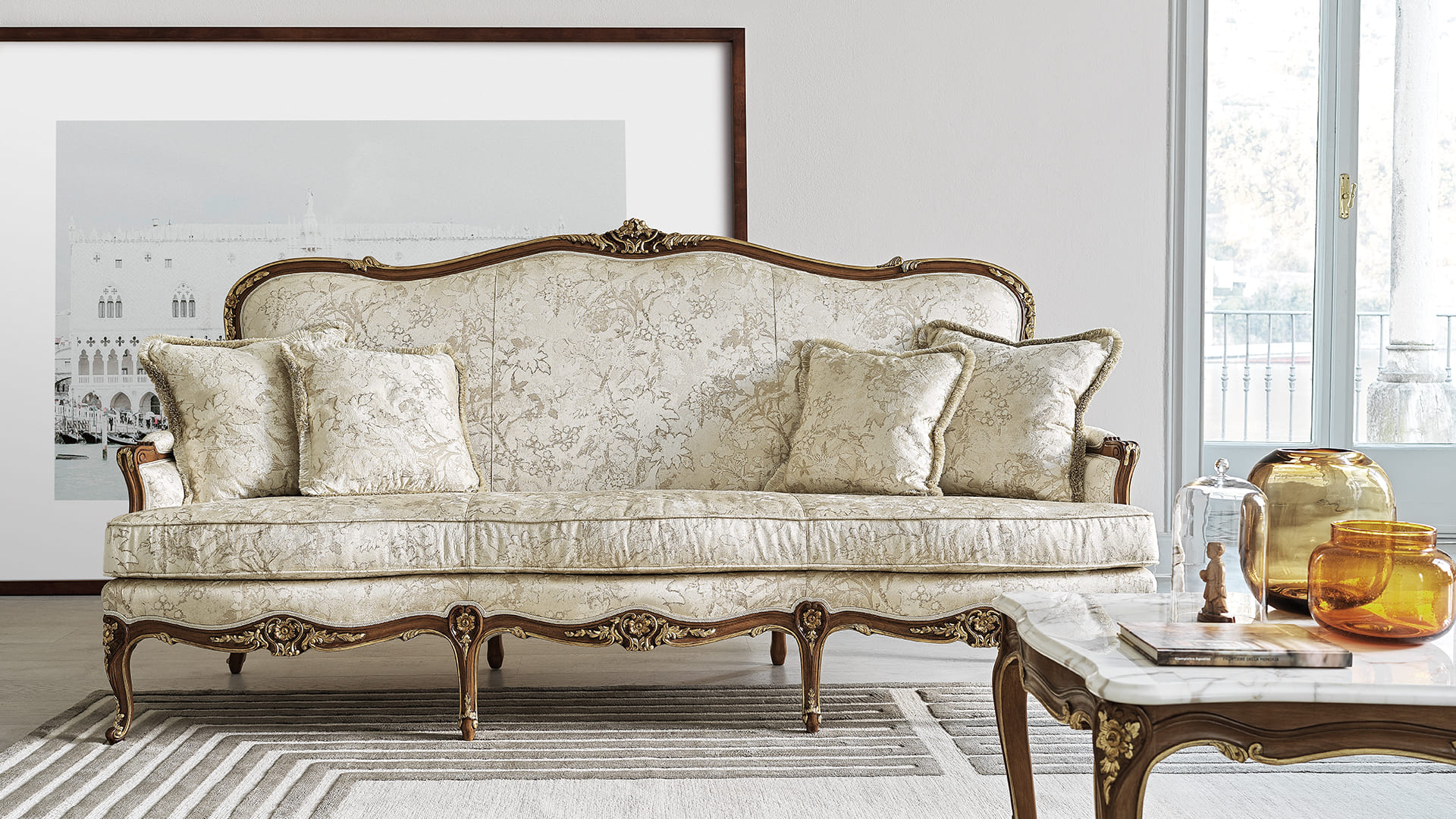
22 Jul Louis XV furniture: a light style with natural shapes
Louis XV furniture: a light style with natural shapes
Asymmetrical lines, sinuous and dynamic forms, decorations under the banner of the most inspired naturalism are just three of the many features that make Louis XV style furniture one of the most easily identifiable by all fans of classic interior design and period furniture.
In order to understand exactly its peculiarities, however, it is important to take a step back and devote ourselves first to some historical background.
Louis XV style furniture originated in France, during the regency of King Louis XV of Bourbon. In this case, our reference years are those between 1720 and 1760, during which a real revolution in interior design and the whole concept of decorative arts occurs. A change so disruptive that it influenced all those that followed but, at the same time, led above all to the birth of a style of furniture that is still considered among the most recognizable in existence today.
It is also important to point out that the “imaginative” aspect that characterizes the furniture of this current is strongly connected to the court philosophy and culture of the time: the aristocracy is now on its way to decline, and faces the decline of its existence by evading reality and devoting itself primarily to mundane events.
Between the early and mid-eighteenth century, the French nobility is thus mainly engaged in the so-called “lounge life“, and the furnishings of the period embody his needs, his aesthetic taste, and his idea of the world: luxurious, elegant and rich in details, but in a way also characterized by a certain inherent evanescence.
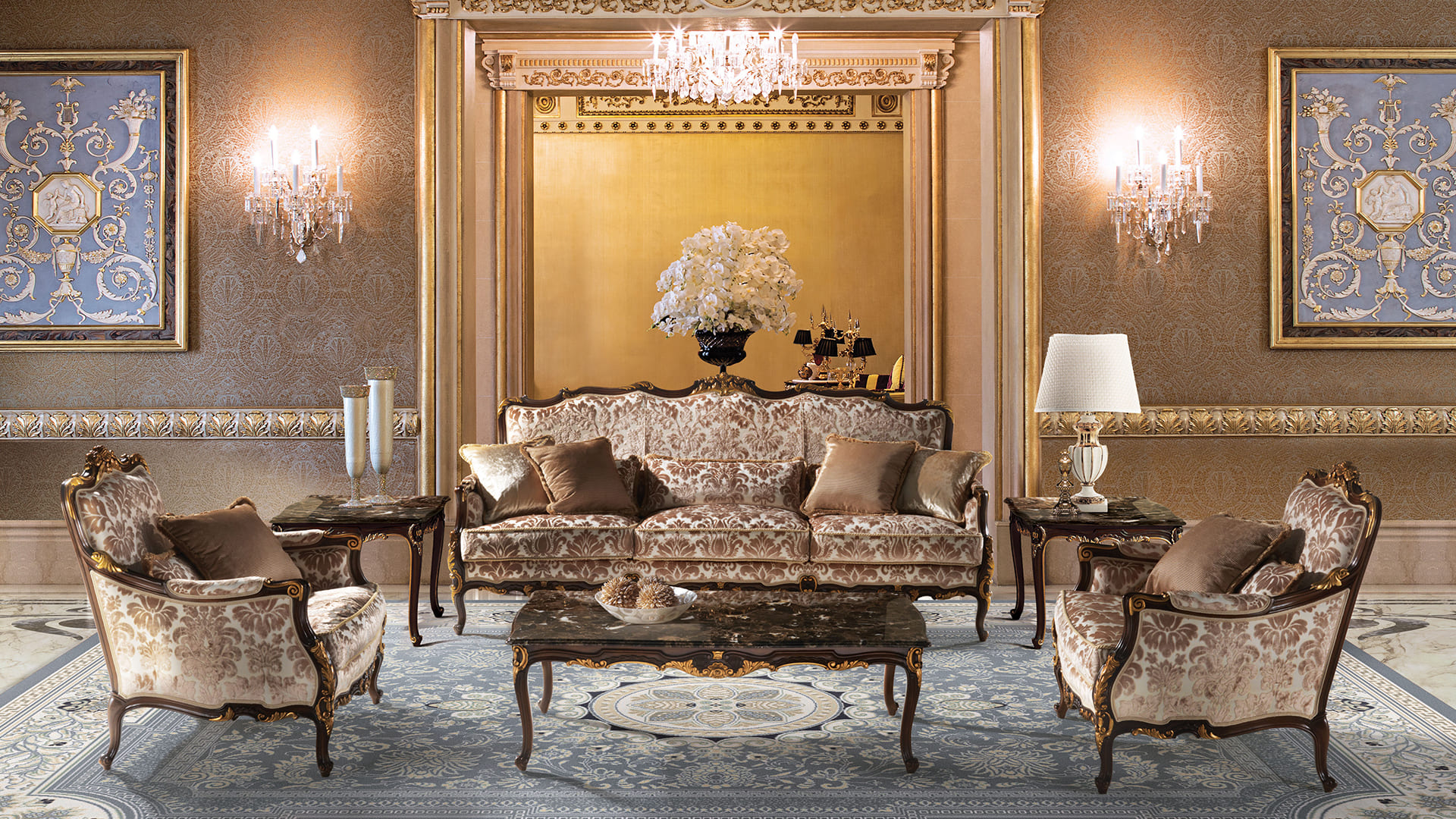
The characteristics of Louis XV style furniture
Louis XV style furniture has very specific characteristics that we only mentioned in the opening of the article. Compared to the monumental, imposing furniture of the past, we are now faced with lines marked by marked asymmetries, slender and sometimes almost nuanced forms, sinuous and elegant silhouettes, decorated almost always with natural motifs.
It’s the time of patterns, designs, carvings and color games that recall all that is nature: one example is the so-called rocaille decoration, which is usually done by combining shells and stones and turns into the ever-present leitmotif for a plethora of decor elements.
The rooms furnished in the Louis XV style are also splendid to look at thanks to the mixture of different materials: in addition to the ever-present wood (prevalent are mainly fir, oak and poplar), there are now also the bronze, porcelain, natural stones, sumptuous and richly decorated fabrics, and lacquered finishes that seem to take inspiration from the East.
More than anything, though, Louis XV style is revolutionary because it inserts into spaces entirely new furniture elements: some examples are the bureau-plat, a desk with a very light aesthetic that has curved legs and three drawers; the flap secrétaire with its many drawers; and the bonheur du jour, a kind of dressing table that is also used for correspondence, however.
Particularly noteworthy, finally, is the chest of drawers, called commodes, still considered the absolute most representative piece of furniture of this interior design current. Like all other pieces of furniture, it, too, is distinguished by its softly curved silhouette, displays typically domed sides, and precious inlays in naturalistic styles (mostly floral suggestion) or inspired by oriental art. The legs, in full assonance with typical elements of the Louis XV style, are curved in a precise S-shape.
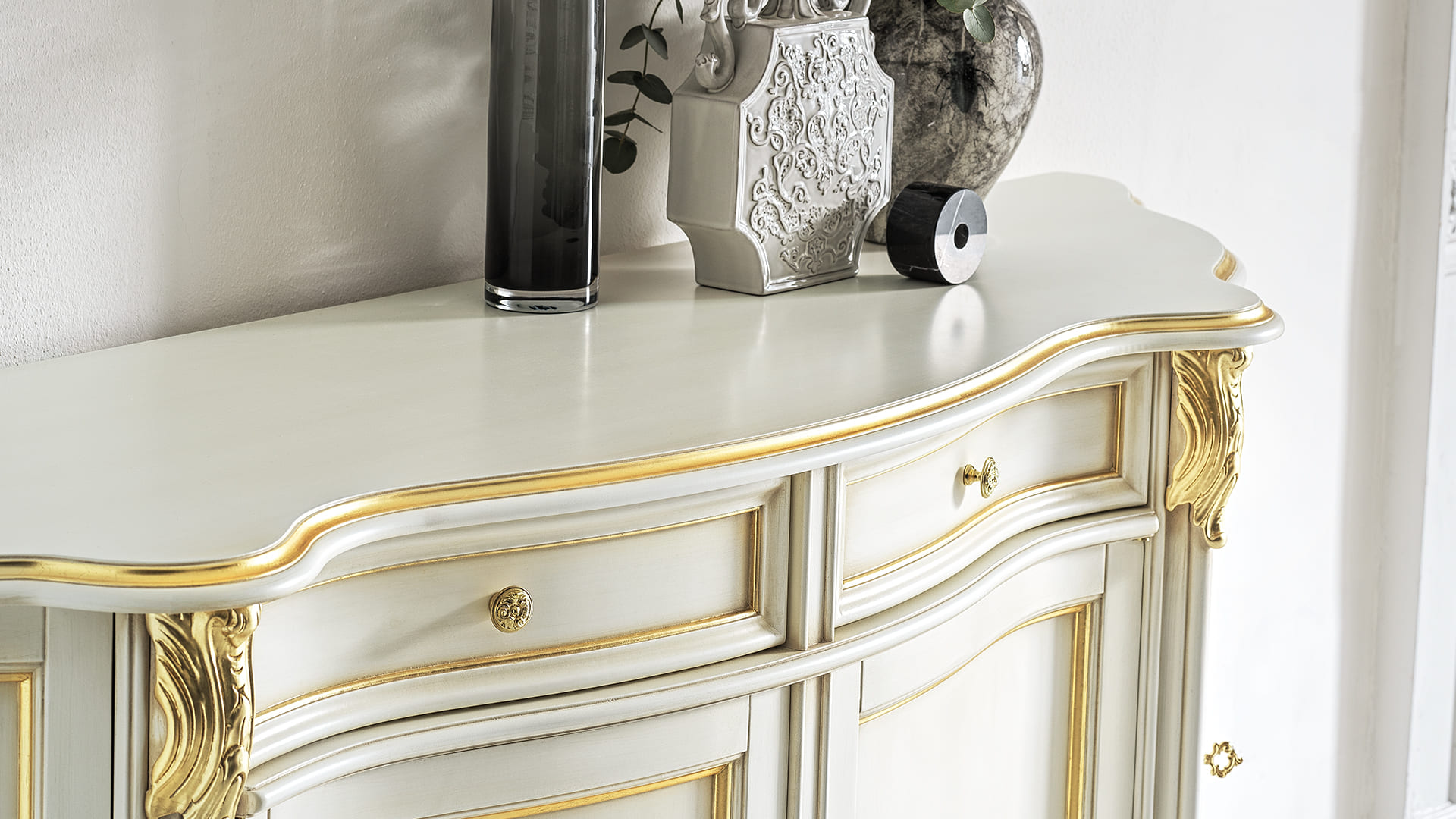
The rooms of the house in the Louis XV style: here are some suggestions
Decorate your home in Louis XV style means being able to clearly recognize the characteristics that identify each piece, and having the ability to combine them optimally so as to create environments well delineated in aesthetics and function, capable of representing a meeting point Between the elegance of period furniture and the current housing need.
The clarification to be made in this regard is related to the very essence of classical furniture. This is not a combination of elements created to create démodé spaces but, on the contrary, a stylistic synthesis designed to enhance the splendor of some of the most iconic pieces ever conceived. In practical terms, this means that a décor with traditional furniture can still be current and remarkably integrable to today’s lifestyle.
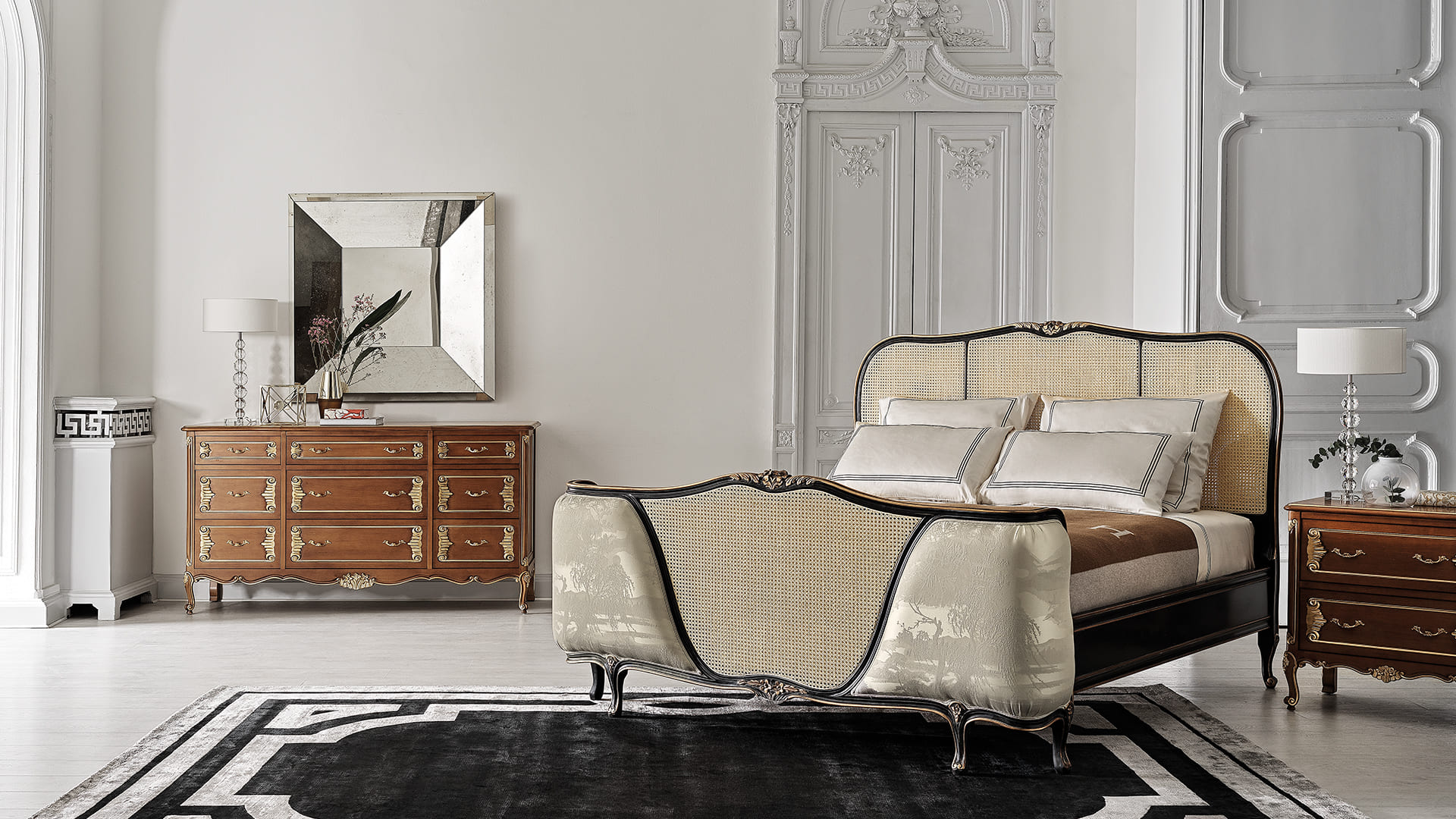
Those who choose to furnish their homes following this philosophy are able to identify the meeting point between the typical characteristics of each element and complement and their actualization, creating sophisticated and timeless environments in which each piece of furniture is a representation of pure craftsmanship.
As for the various rooms in a house furnished in the Louis XV style, the elements we described just above certainly cannot be missing: the desk, dressing table, and dresser, all great “pillars” of this current.
Their placement is generally quite versatile: the former will be able to find a place in the study or home office, but also in the living room and even in the foyer by virtue of its lightweight aesthetic. The second is strictly for the bedroom, not only because of its function as a console table but also because the exchange of missives represents a precious and private moment to be experienced in the most personal spaces. Finally, the commode was born for the bedroom but is versatile enough to be a central element in any type of room after all, nothing is more flexible in its use than a dresser.
For the living room, the key is obviously the armchairs and sofas. Both of these pieces of furniture are identifiable as being in the Louis XV style when they display a domestic wood construction, such as oak, beech, or walnut. The shapes should, of course, respect the stylistic features of suppleness and visual lightness typical of this movement. In addition, the backrests will be lower than in the past, and the seats will become wider and more comfortable, inviting relaxation also thanks to the presence of the large upholstered armrests. The legs of the sofas and armchairs-but also of the chairs-will be strictly exposed, slender and curved, a far cry from the baluster structure that characterized Louis XIV design.
Some of the most popular armchairs for furnishing a Louis XV-style living room include the duchesse and the à la reine model, as well as the well-known bergère and marquise. The former has a particularly curious origin, as some believe it owes its name to the famous Madame de Pompadour, the sovereign’s favorite: it has a sloping back and a deep seat made even more comfortable by the recessed, padded armrests.
The bergère, born in 1725, on the other hand, boasts a wide back that becomes one with the armrests and a very generous seat with a “full” aesthetic. The seat is enhanced by a soft cushion covered in the same fabric that covers the entire element.
As for sofas, the models of the era fit into spaces that were dimensionally less grandiose than in the past and, therefore, became smaller. There are various types available, almost all designed to seat three people. The most famous is undoubtedly the so-called marquise, which to the eye looks almost like an enlarged and carefully shaped armchair. The main alternative is the duchesse sofa, with its seductive gondola back.

And what about the Louis XV-style tables? Their silhouette is certainly simpler and lighter than in the past, and the available sizes are expanding in the name of increasingly versatile and multifaceted home environments. The cabriole legs help give a ethereal and almost elusive look, while the proposed types recall the concept of multifunctionality that is now beginning to make its way into the furniture industry: room for emptying pockets (vide-poche) at the entrance, at the chevets employed as bedside tables, to jewelry tables (serre-bijoux) for the boudoir, and, for the living room, to tables à ouvrages-true pieces of furniture with multiple uses sometimes also called tricoteuseso chiffonnières.
For Louis XV-style bedroom furniture, the centerpiece of the room will be a splendid four-poster bed – the latter, though changed in aesthetics, is a piece of furniture that in fact seems to have been handed down substantially unchanged from style to style. Compared to the past, however, its overall aesthetics are significantly less imposing, and the dimensions are reduced especially in the new models à la polonaise. Compared with Louis XIV-style four-poster models, à la polonaise beds have other different identifying features: for example, the backboard is the same length as the bed, and the canopy is decorated with precious drapery.
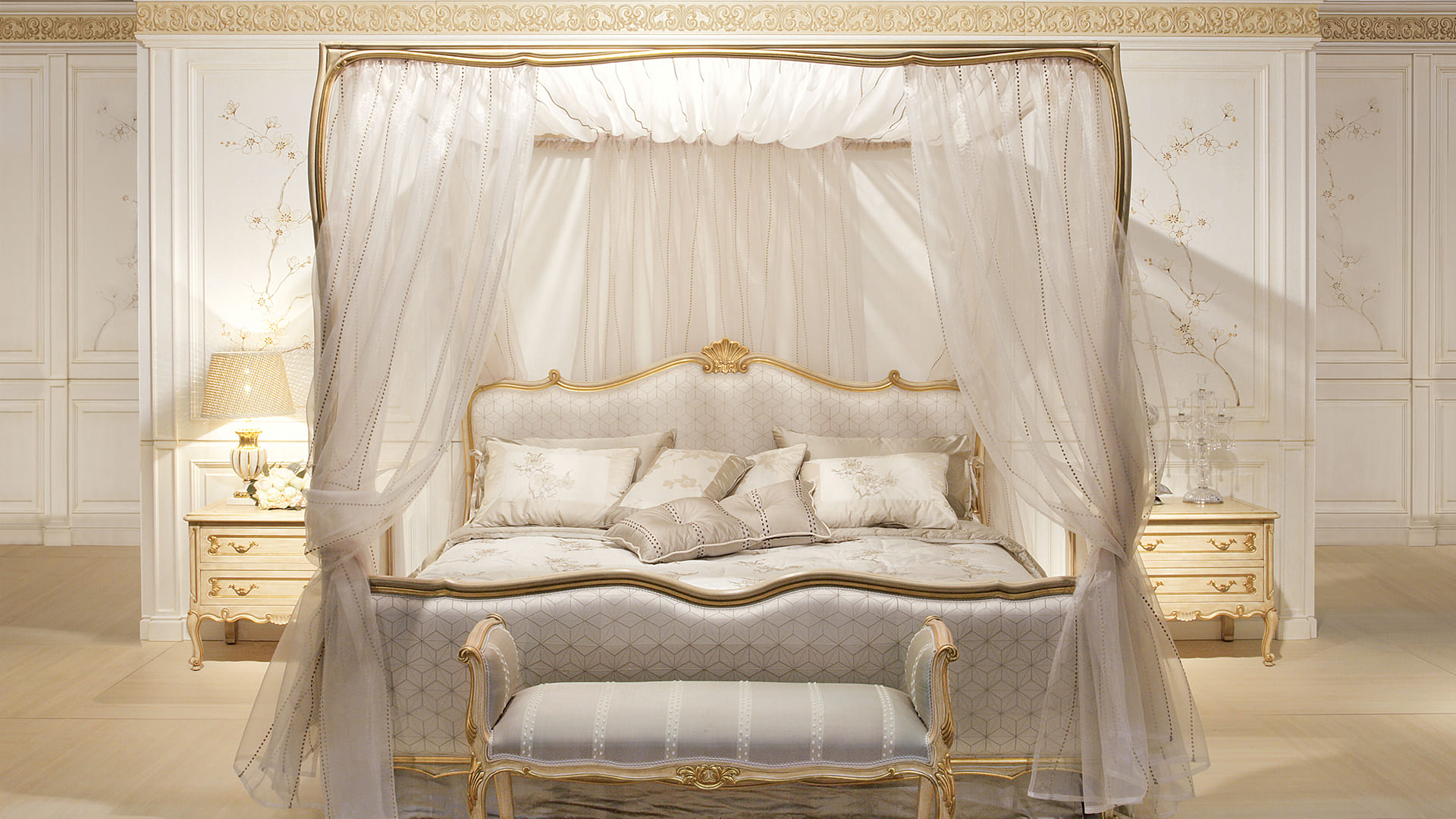
Angelo Cappellini: Italian quality craftsmanship for your Louis XV style interior design
Today, Angelo Cappellini is synonymous with classic furniture in Italy and around the world, thanks to the extraordinary skills of its master craftsmen and a design approach that updates each piece, making it perfectly integrable even in today’s residences.
In the Italian company’s catalogs, the Louis XV style is explored with elegant collections with attention to the smallest detail and characterized by the careful selection of materials, finishes and workmanship: Massini, Canale, Belli, Mantrovani, and Giusti are some of the solutions offered by the brand to the Louis XV-style décor of the living room in which the preciousness of the textile elements complete, like the canvas of a visual artwork, the spectacular framing of forms.
Also for the Louis XV bedroom Angelo Cappellini offers all the answers with the collections Leoncavallo and Strauss: sumptuous furniture elements that tell the story a private space permeated with the immortal elegance of a style that is the epitome of sophistication and simplicity at the same time, of design accuracy and formidable artistic vocation.
Get in touch with our specialists to receive more information or a dedicated consultation for your Louis XV-style interior design project.
